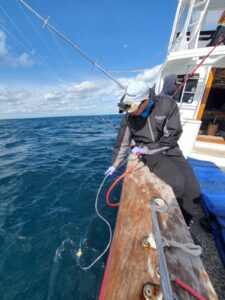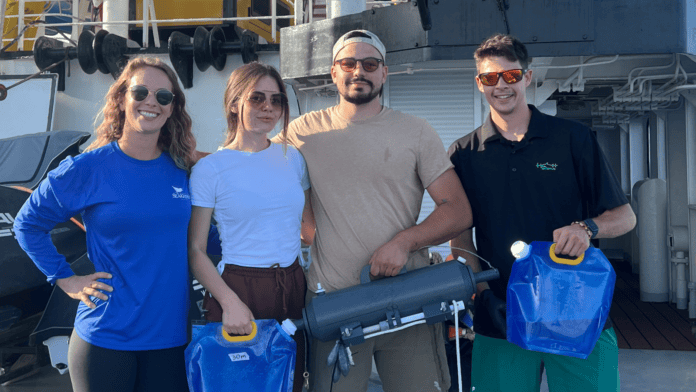The Mediterranean white shark is as elusive and mysterious as the sharks in the Atlantic and Pacific are well known.
“There’s really not much known about them, and they are crucial to the ecological balance as apex predators,” said Jeremy Jenrette, a Ph.D. candidate in the Department of Fish and Wildlife Conservation. “The Mediterranean Sea is one of the most exploited oceanic regions in the world.”
On a quest to gain more knowledge about the Mediterranean white shark, the SeaQL at Virginia Tech Lab is collaborating with the nonprofit organization International SeaKeepers Society and Virginia Tech’s Genomics Sequencing Center to leverage environmental DNA, known as eDNA, in the hunt.
Utilizing a network of volunteer citizen scientists armed with a simple testing kit created by Jenrette, surface water samples of eDNA are being collected along the Mediterranean’s borders with 22 countries. The samples are then sent to Blacksburg to be analyzed for the genetic material sharks shed through their saliva, epithelial skin cells, and feces to help reveal the fish’s locations.
“There’s this really cool opportunity to increase awareness and scientific knowledge of the sharks’ conservation status by scaling up and involving international boaters,” Jenrette said.
In the past year, this work has helped produce findings published in two articles in Frontiers of Marine Science – one documenting the search for white sharks in the Mediterranean, and the other reporting the first-ever satellite tagging of a juvenile shortfin mako shark in the region.

The project is a part of the White Shark Chase, which launched in 2020 to observe, gather data, and tag white sharks in the Mediterranean. Led by Assistant Professor Francesco Ferretti in the College of Natural Resources and Environment, researchers are working to leverage multiple approaches and diverse data streams, including eDNA, to better understand the ecology of the sharks and enhance their conservation.
“The White Shark Chase is an unprecedented initiative,” Ferretti said. “We seek to expand and consolidate into a long-standing monitoring program in the region to save these important and genetically unique predators as well as other endangered sharks in the region.”
The White Shark Chase is one of multiple efforts Ferretti is involved with to better identify shark populations and analyze their role as sentinels for overall ecological health.
According to the International Union for Conservation of Nature, the white shark is listed as critically endangered in the Mediterranean Sea. More than 50 percent of the region’s sharks and rays are considered threatened with extinction in the region and more than 25 percent are considered data deficient.
Searching for sharks in the Mediterranean’s broad waters requires planning and international collaboration. In 2023, the International SeaKeepers Society contributed more than $3,500 in seed funding to help scale the eDNA project to include citizen scientists.
According to its website, the society’s mission is to use privately owned yachts for oceanographic research, educational outreach, and marine conservation.
“By collecting eDNA samples as they travel, boaters are able to contribute valuable data and improve our understanding of elusive white shark populations in the Mediterranean Sea — a recreational boating haven,” said Vicky Neild, UK programme manager for SeaKeepers. “The boating community is uniquely positioned to expand the project’s data collection capacity, empowering all to have a profound impact on marine conservation.”

In May 2024, the society facilitated access to a large marine vessel, the TE STREEP, for support in an eDNA expedition to the Adriatic Sea, the northernmost sea of the greater Mediterranean. Its program manager, Aubri Keith, accompanied Jenrette on the trip, during which he demonstrated the simple $200 water testing kit he created for the citizen scientist crew and created an instructional video.
Once used, the kits are sent to Blacksburg to be analyzed by the Genomics Sequencing Center, where Jenrette’s mother, Jennifer Jenrette, is part of the team.
A next generation sequencing specialist, Jennifer Jenrette has been analyzing the eDNA samples since the beginning of the project. She also joined her son as a co-author of a paper detailing the success identifying the presence of the white sharks. It was published in Frontiers in Ocean Observing in 2023 and helped expanded the center’s reputation in a manner than has drawn requests from researchers outside of Virginia Tech.
“Together we were able to use several different molecular strategies to select, amplify, and detect multiple marine species and also target the white shark,” said Jennifer Jenrette. “Being listed as second author on his publication is pretty cool and rather unusual. Not many parents get to observe their child’s higher education, growth, and maturity at this level.”
The Jenrettes’ combined efforts on the current project have helped successfully confirmed white shark detection in the Sicilian Channel and in the Adriatic Sea near Croatia.
“We processed 50 eDNA samples, including 12 tissue and aquarium samples as controls, from the Adriatic Sea, the Sicilian Channel, and Sardinia, and we detected 15 shark and ray species with a greater than 95 percent match,” Jeremy Jenrette said. “The top five most abundant species we observed were shortfin mako shark, white shark, porbeagle, blue shark, and blackfin guitarfish. Additionally, six out of the nine citizen science samples detected sharks and rays with a greater than 99 percent match.”
Because the eDNA sampling has proven to be an effective noninvasive means of data collection, the researchers have expanded the scope of the project to include a greater range of rare and elusive species.
“By supplementing traditional techniques, eDNA fills crucial knowledge gaps, enabling more robust conservation and management decisions for vulnerable Mediterranean populations of rays and sharks,” Jeremy Jenrette said. “We need to utilize more innovative technological approaches to sniff out their remaining populations because they are so elusive and scarcely observed.”
Ferretti said taking on the immense challenges of the White Shark Chase depends on sustained funding, which has historically come in small, piecemeal contributions from philanthropic organizations. Despite the limited resources, the SeaQL team and its collaborators have successfully gathered preliminary data and identified the area that appears to be the last stronghold of Mediterranean white sharks — the North African coasts.
“We are incredibly close to tagging the first Mediterranean white sharks,” Ferretti said. “We now know where they are, we just need the means to reach them and begin monitoring before it’s too late. Thus, every donation, no matter the size, or infrastructural support, helps move us forward on this critical conservation effort.”
The SeaQL Lab team includes:
- Brendan Shea, Ph.D. candidate in the Department of Fish and Wildlife Conservation
- Andre Lai, master’s degree student in the Department of Fish and Wildlife Conservation
- Italian collaborators Chiara Gambardella, Ph.D. candidate, and Stefano Moro
Original DOIs: https://doi.org/10.5670/oceanog.2023.s1.28, https://doi.org/10.3389/fmars.2024.1423507, and https://doi.org/10.3389/fmars.2024.1425511
By Felicia Spencer


